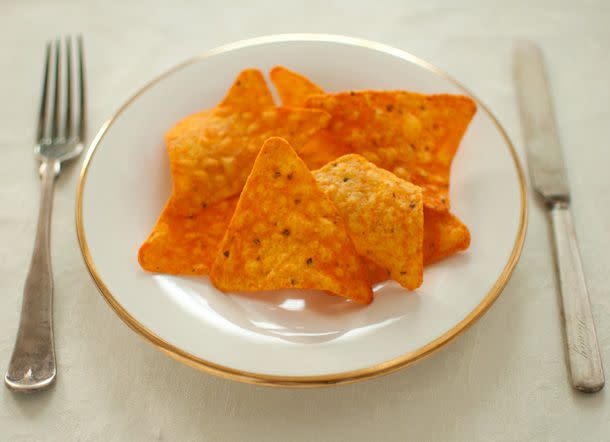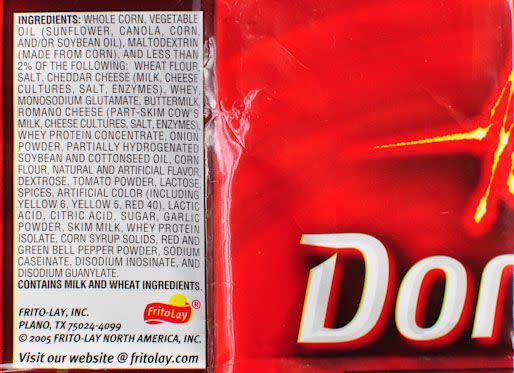Why Nacho Cheese Doritos Taste Like Heaven
The science behind that cheesy seasoning that's stained millions of fingers.

Serious Eats
I'm not going to start things off with childhood anecdotes of good times spent around a freshly opened, crinkly bag of Doritos. And it's not because you, as Serious Eats readers, deserve more (though I'm sure you do). It's because, with Doritos, it's not about nostalgia—it's about science.
I don't love Nacho Cheese Doritos because my late grandfather used to sneak them to me under the pew during tedious Sunday sermons (he didn't). And I don't crave their cheesy crunch all times of the day because my grade school crush, Bridget McElroy, sported an ever present orange film of "cheese" under her fingernails (though to be fair, she probably did). They taste like heaven because their creator, Frito-Lay, designs them to.
The crunch of Doritos (something I plan to cover in great detail in a later post) is incredibly important, but today we're focusing on the cheesy seasoning. And for that we need to look at the ingredient list.

Serious Eats
At first glance it's a bit overwhelming (maltodextrin and sodium caseinate, you say?), but with closer inspection we find a common thread: ingredients rich in glutamic acid, the molecules that provide the savory quality known as umami.
There are a few natural umami bombs in there, namely Romano cheese, cheddar cheese, and tomato powder. Slightly less potent (umami grenades?), though still packing their own glutamate punch, are onion powder, garlic powder, and the various forms of whey. If Frito-Lay were to stop right there they'd probably have a pretty good chip on their hands. But they aren't interested in making a pretty good chip; they're crafting Doritos.
To reinforce these sources of naturally occurring glutamic acid, they go for the nuclear option: pure monosodium glutamate (MSG), the sodium salt form of glutamate (I hope that by this point Serious Eaters are aware that MSG's reputation in the '60s and 70s for making Chinese restaurant-goers sick is fully undeserved). You may be thinking that since a little MSG goes a pretty long way to upping the umami factor, Frito-Lay probably stops the onslaught there, right? Wrong. The last two ingredients on the list (meaning that they appear in the smallest quantities) are arguably the most important: the free nucleotides disodium inosinate (IMP) and disodium guanylate (GMP).
Both IMP and GMP are what professional flavorists refer to as flavor potentiators—which just sounds awesome. To continue our arms race analogy, IMP and GMP are the heat-seeking ballistic missiles of the group. They fly in first, target taste receptors for umami and physically alter them, allowing the glutamate bombs better access (to destroy your mouth with flavor!). Put another way, with these flavor potentiators (YES!) in the mix, our perception of glutamates is amplified up to 30 times. Want a buzzword for it? Synergy.
I understand that this might sound like mad science, unfit for human consumption, but if we back up just a bit, I'll show you that it's not so crazy.
We humans have been taking advantage of this flavor synergy for a long, long time, whether we were aware of it or not. Japanese dashi broth combines glutamate-rich kombu seaweed with IMP-rich bonito katsuobushi, while a caesar salad features the synergy of anchovies (which contain a big hit of IMP) and glutamate-packed Parmigiano-Reggiano. Even the humble cheeseburger (where cheese provides glutatmates and beef supplies the IMP) puts this science into practice. All Doritos had to do was look to culinary history for guidance and Ajinomoto for isolated forms of these tasty, tasty molecules.
And a glance at the quote on the back of the bag suggests that Frito-Lay knows exactly the brand of flavor havoc they are wreaking: "Experience that ballistic Doritos brand crunch as it unleashes an explosion of nacho cheese flavor in your mouth." I couldn't have said it better myself.
This story was originally published as part of a column called "Chip-Faced," and was published with the following note: "Our buddy Dan Souza has always been fascinated with the world of chips. We want the man to nerd out about chips here, and explain to us why they taste so damn good. He'll investigate various chip styles, flavorings, and discontinued varieties. Take it away, Dan! —The Mgmt."
